-
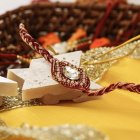 Gift Your Sibling Something Unique on Raksha Bandhan 2019: Choose from Our 12 Recommendations for Brothers and Sisters to Let Them Know How Much You Care!
Gift Your Sibling Something Unique on Raksha Bandhan 2019: Choose from Our 12 Recommendations for Brothers and Sisters to Let Them Know How Much You Care!
-
 8 Beautiful Rakhis for Brother and 10 Creative Rakhi Gifts for Sister (updated 2019). Plus A Look at the Traditions Surrounding Rakhi
8 Beautiful Rakhis for Brother and 10 Creative Rakhi Gifts for Sister (updated 2019). Plus A Look at the Traditions Surrounding Rakhi
-
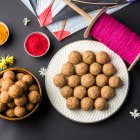 Celebrate Makar Sankranti the Traditional Way: What to Do and How to Do It Plus 10 Great Gifts to Give Family and Friends (2019)
Celebrate Makar Sankranti the Traditional Way: What to Do and How to Do It Plus 10 Great Gifts to Give Family and Friends (2019)
Different Saree Styles for Durga Puja

Durgotsav' or 'Sharadotsav' is a significant festival which is rejoiced not only across the nation but also across the globe. The arrival of Durga Puja starts from 'Mahalaya', which happens seven days before the Puja itself. Every house is decorated with lights and flowers, and elaborate structures of puja pandals are set artistically. Different traditional outfits are worn, especially sarees which are Bengal based makes each man and woman a show stopper during puja days.
Bengal Cotton Sarees

Bengal cotton sarees are the most popular ones worn by women of Bengal as these are lightweight and airy textured. It's suitable for everyday use, especially during summers. These can be printed in floral or paisley and other artistic motifs in a variety of colourful patterns.
Tant Sarees

Tant is a cotton handloom saree which is characterized by the thick border and woven motifs of thread in various colours. It has a decorative 'pallu' and a relatively plain body. It looks luxurious and traditional and comes in thin cotton and blended silk base. It is better to wear the 'pallu' neatly pleated and loosely pinned to give a chic, traditional and ethnic look.
Jamdani Sarees
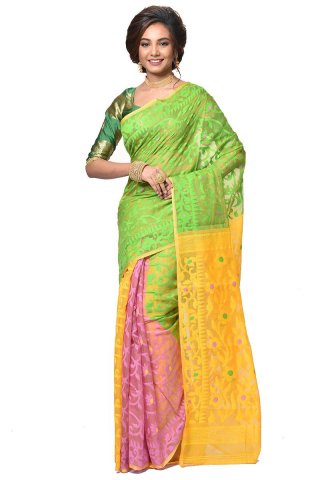
The name 'Jamdani' is Persian, which translates to 'Jam for flowers, 'Dani' for a vase. The motifs give a luxurious look which comes in many varieties. It has a rich history and heritage, and a popular form of jamdani are the 'Dhakai Jamdani' which is an art of textile weaving in Dhaka, Bangladesh.
Red and White Korial Gorod
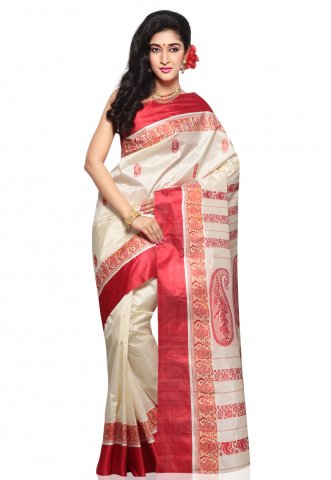
Durga Puja is incomplete without a red and white combination saree, especially during Dashami. The Gorod or Korial Benarasi is an ethnic and old traditional choice among all red and white combination of sarees. Mostly the mothers wear this kind of saree which looks extremely elegant. This gorod or korial silk red and white saree comes with broad border and pallu, and no designs in the body of the saree.
Best Sarees to Wear During Durga Puja
Cotton Tant Saree
When you see a saree with a thick border, decorative pallu woven with motifs of different thread and in handloom base, you can identify it with the Bengal Tant saree. It is light and simple looking with a fine transparent base. It is extremely comfortable for hot and humid places like Bengal. It is very comfortable to drape as it is soft and nicely woven. It is considered as the ever-pleasing saree with a bright border and designed pallu.
The cotton tant saree from www.adimohinimohankanjilal.com, which is an exclusive and very well-known saree hub of Kolkata, has some never-ending variety of sarees. This saree from the shop is light beige and crafted with red Resham and golden zari work of leaf and floral but scattered all over the body. The pallu is designed in weaves of Resham and golden zari designer work. The saree comes with a designer worked border in with golden zari. It comes without blouse piece so you will need to try some matching blouse with the saree. The weight of the saree is 1 kg, and it can be worn in all regular occasions and also on the mornings of Durga Puja days. The price of this saree is Rs. 3,690 inclusive of GST and other taxes.
Tussar Silk Saree

Tussar silk is also referred to as the 'wild silk' or 'tussar silk' which can be considered as a discovery of medieval times. Desi tussar silk sarees are also known as 'Kosa Silk' sarees, which is produced from silkworms. Tussar silk is a lot more textured than any other silk, and it is cooler fabric and porous in nature, which makes it more breathable. It is extremely wearable in warmer parts of the country. It still needs to be dry cleaned every three months, to keep its freshness, sheen and lustre. Generally, tussar silk sarees have a natural dull gold base which makes it unique to wear in Indian weddings or festivals like Durga Puja. It can also have nature-inspired motifs or embroideries beside the solid base. If you store them in muslin bags, then they can be well maintained.
www.Itokri.com is one of the personal favourite online store, where you can get exclusive handmade sarees without any worry. The red handspun pure tussar silk pochampally ikkat saree with the following blouse piece has a very smooth texture. Ikkat is a dyeing technique used to create a pattern in textile, and it comes in lovely patterns and gorgeous colors. This precious work of art will make you feel special as it shouts for masterful craftsmanship and admirable design. The price for this exclusive handmade precious saree is Rs. 15,750.
Dhakai Jamdani Saree
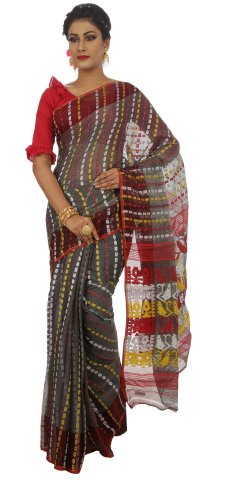
Dhakai is a woven fabric and one of the best varieties of finest muslin. It has been one of the most artistic textiles from Bangladesh as the name suggests itself. It is blending of the ancient Hindu traditions and Mughal patronage. The material is as light as a feather, and it represents the finest and one of the ancient form of weaving originally from Bengal. Dhakai Jamdani is characterized by its finest fabric quality, intricate design and lightweight material. UNESCO has declared this traditional art of weaving as an Intangible Cultural Heritage of Humanity. It is of Bengali origin and most time consuming and labour-intensive forms of loom weaving. Dhakai Jamdani sarees are made with the supplementary weft weaving technique and the motifs, floral or figured are produced by non-structural weft along with the standard or basic weft. The patterns are mostly motifs of plants and floral designs with geometric patterns.
Among various colours, one of the common choice in dark shades is the combination of grey and red Dhakai. This silk-cotton jamdani saree from Bangladesh has a soft and starch-free texture, which makes it a pleasure to drape. The body is of grey shade with red, white and yellow floral motifs. You can pair it with a red blouse for a charming look. The price for this mystical saree is Rs. 3,750., and is available on www.parinita.co.in
Baluchari Saree
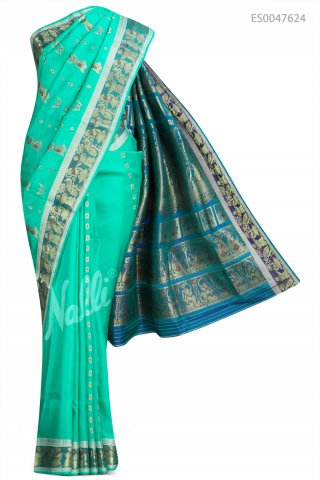
When you are adding a 'baluchari' to your wardrobe, you are bringing home, 'seven yards' of India's complex and rich history. It is one of the most exquisite silk sarees from Bengal with a gorgeous border and pallu which depicts the tales and sense of the ancient historical epic stories and religious texts. Baluchari is apt for wearing at festivals like Durga Puja, weddings and grand functions. There are various types of Baluchari sarees - some with resham threads in a single color to weave various pattern and designs, meenakari work which brightens the pattern, and also swarnachari or baluchari in gold which is the most gorgeous baluchar is woven with gold or silver-coloured thread. It is ahandwoven saree richly dyed with silk, with intricate motifs. Designs are mainly from the tale of Ramayana and Mahabharata. It is a symbol of aristocracy and status.
The beautiful green Baluchari silk saree is woven with Zari and Thread Butta on the body and Zari border. The sari includes unstitched blouse. Each Baluchari saree is unique, and the material is silk, it is half-fine zari, which makes it perfect for wedding and festivals. The length of the saree is 5.4 meters and comes with a matching blouse piece. The price of this unique baluchari silk saree is Rs. 10,547. It is available on www.nalli.com
Bomkai Saree
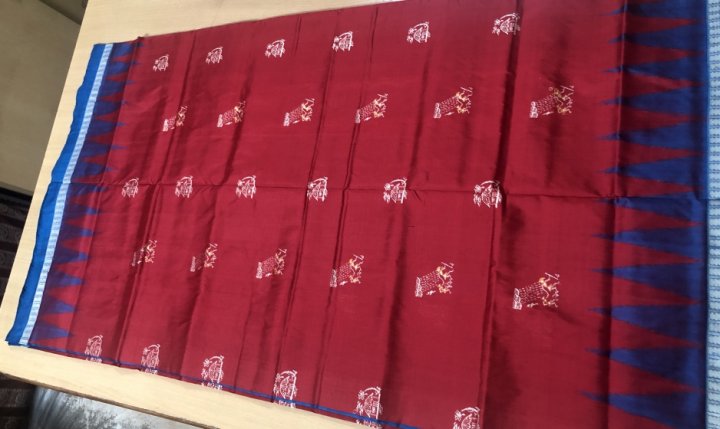
Bomkai Saree is also known as Sonepuri Saree which is a beautiful fabric originally from Odisha, the village named 'Bomkai' in Gangnam district. This fabric is made from low count cotton yarn and comes with various motifs like all over fish, dumroo, kanthi phool or even bitter gourd, all from the tribal influence. Generally, to add a dominant flavour to the look of Bomkai, a Kamar band can be added to the entire attire. Bomkai is a customary fabric which is created by making use of the 'Ikat' dying technique. The hand-weaving method of 'warp and weft' is applied for creating Bomkai sarees. You can easily recognize Bomkai saree by its pastel-coloured body, a bead form border, the 'Ikat' design and the rugged temple design which flows from the side of the border. The border is mostly applied with a lively and contrasting combination, and it is mostly dyed in 'double colour' which is another feature of the saree. The saree border is also decorated with the motifs like 'diamond shapes', 'earthen pots', 'flower designs', and 'decorative beads designs'.
The four primary colours which are used to decorate Lord Jagannath are used in Bomkai sarees. The pallu is weaved with gold and silver cords, and many conventional tribal designs are used to create the pallu. Few groups of Bomkai sarees are Sambalpuri, Sonepuri, Pasapali, Barapali, and Bapta and most of the designs are influenced by the nature, mythology, history and the iconic symbols of our country. www.orissahandloom.com has many online collections of beautiful Bomkai sarees, among which this silk Bomkai with the combination of red and blue, attracts many saree admirers. It has lovely colour contrast and a bright border with traditional temple work. The price of this saree is Rs. 12,000.
Kantha Stitch Saree
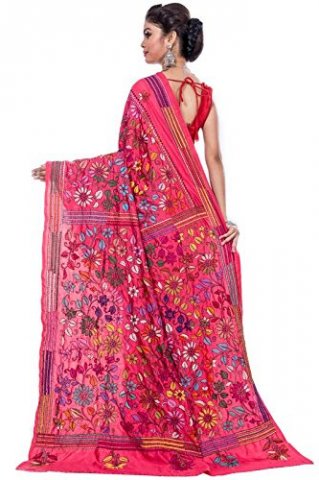
Kantha was originated from the simple embroidery work on discarded garments or clothes. The name ‘Kantha’ means ‘rags’ which are used by the rural women to embroider on the clothes. It is one of the ancient forms of embroidery, and its origin can be traced back to the ancient Pre-Vedic ages. The embroidery signifies simple motifs of nature, deities, the sun, the tree of life and the universe.
Kantha is now a household fashion symbol which is well-appreciated in the form of art used in traditional sarees. Kantha stitch on the handloom silk saree from www.amazon.in, which is bright pink in colour, comes with a blouse piece. It is 6.3 meters, and is very soft and lightweight. The price for this saree is Rs. 3,577 with free delivery option.
Korial Benarasi Saree
Durga Puja celebration and without a red and white, old traditional saree? No way! A red and white combination is a symbol of Bengalis. The conventional 'Sankha-Pola' which is a combination of bangles, white and red and a saree with the same color combo, can make you look different from the entire crowd of the world. If you really want to drape yourself in an authentic and something that all the generations of women are wearing during marriage ceremonies and Durga Puja, it is the Korial Banarasi.
A korial is a grand version of the 'garad' saree. Just like garad silk, it has a white or off-white body and a traditional red-coloured border and pallu. The fabric is rich textured silk, and it is decorated with more ornamental and intricate motifs. These lavish silk saree comes with a plush white or off-white base and gold or silver embellishments, which are the significant characteristics of Banarasi silks. The red and white Korial silk banarasi, from www.adimohinimohankanjilal.com has a patli-pallu design, and it is crafted with golden zari designer work along with contrasted border. It comes with a red blouse piece, and it weighs around 2 kg. The price of this traditional saree, which is a treasure to your wardrobe is Rs. 4,815.
Saree Wearing Tips during Four Days of Durga Puja
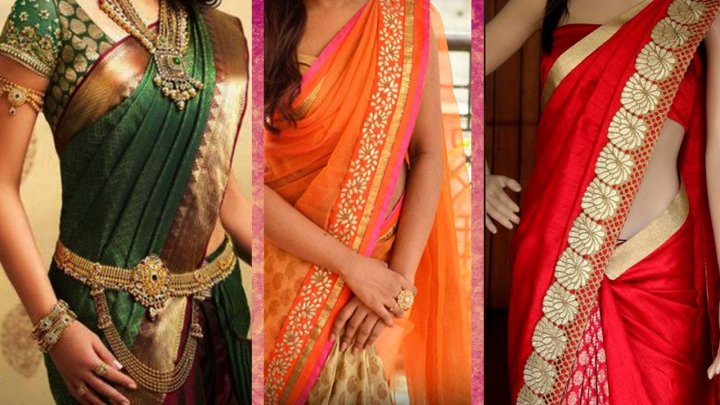
-
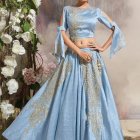 What If You Can Make an Exclusive Designer Dress by Re-Using Your Old Saree(2020)? Create Magic by Transforming Sarees into Lehenga Using Our Craft Ideas and Be Proud of Yourself!
What If You Can Make an Exclusive Designer Dress by Re-Using Your Old Saree(2020)? Create Magic by Transforming Sarees into Lehenga Using Our Craft Ideas and Be Proud of Yourself!
-
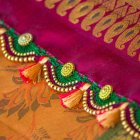 What is Saree Kuchu and How to Find the Perfect Saree Kuchu. 10 Must-Have Designs and Why You Should Use Them (2020)
What is Saree Kuchu and How to Find the Perfect Saree Kuchu. 10 Must-Have Designs and Why You Should Use Them (2020)
-
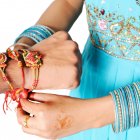 Best Rakhis for Brother in 2020: 13 Rakhi Gifting Ideas to Celebrate Your Beloved Brother
Best Rakhis for Brother in 2020: 13 Rakhi Gifting Ideas to Celebrate Your Beloved Brother
-
 Simple and Easy-To-Create Pongal Kolam Designs To Decorate Your Home Traditionally
Simple and Easy-To-Create Pongal Kolam Designs To Decorate Your Home Traditionally
-
 12 Handpicked Sarees for Weddings to Look Your Best, Plus Get the Lowdown on Trending Blouse Designs in 2019
12 Handpicked Sarees for Weddings to Look Your Best, Plus Get the Lowdown on Trending Blouse Designs in 2019
Dress up in These Best Looking Sarees on the Auspicious Occasion of Durga Pooja
Durga Pooja is celebrated with much pomp and show in different parts of India. On this Durga Pooja, pick out a saree from this amazing collection and get ready for festivities!

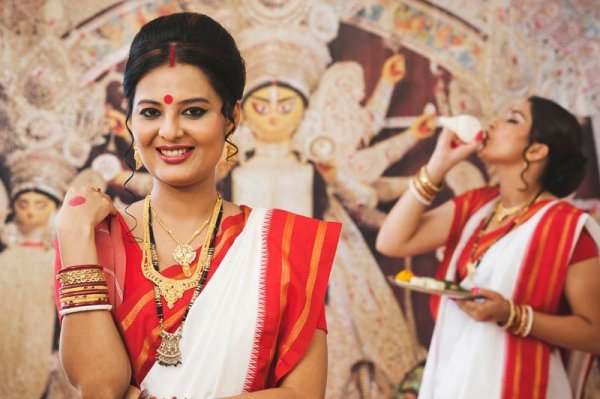


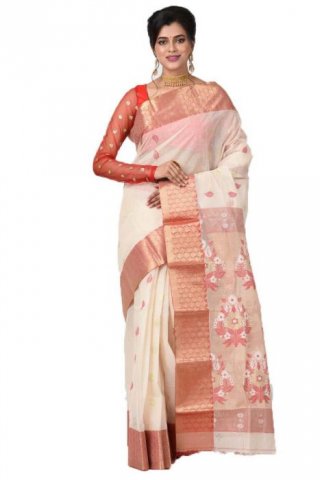

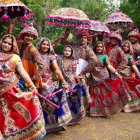
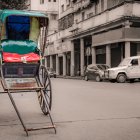
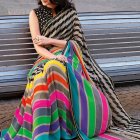
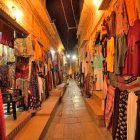

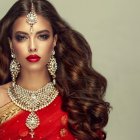
 Highlight the Best Facets of Your Incomparable Beauty: Discover the Best Face Highlighter Currently Available in India and Everything You Need to Know About Using Face Highlighters for Maximum Effect (2023)
Highlight the Best Facets of Your Incomparable Beauty: Discover the Best Face Highlighter Currently Available in India and Everything You Need to Know About Using Face Highlighters for Maximum Effect (2023)
 Forget the Blemishes and Get that Picture Perfect Flawless Radiance on Your Face: Check out the Best Foundations for Oily Skin Currently Available in India and Everything You Need to Know About Makeup Foundations (2023)
Forget the Blemishes and Get that Picture Perfect Flawless Radiance on Your Face: Check out the Best Foundations for Oily Skin Currently Available in India and Everything You Need to Know About Makeup Foundations (2023)
 Make Your Presence Felt Wherever You Go: Discover the Best Perfumes Under 2000 for Both Men and Women to Announce Your Arrival and Make Any Occasion Memorable (2023)
Make Your Presence Felt Wherever You Go: Discover the Best Perfumes Under 2000 for Both Men and Women to Announce Your Arrival and Make Any Occasion Memorable (2023)
 Protect Your Oily Skin from the Harmful Rays of the Sun: Discover the Best Gel Based Sunscreens for Oily Skin and Everything You Need to Know Before Buying One (2023)
Protect Your Oily Skin from the Harmful Rays of the Sun: Discover the Best Gel Based Sunscreens for Oily Skin and Everything You Need to Know Before Buying One (2023)
 Minor Blemishes and Wrinkles Affecting Your Confidence? Check out the Best BB Creams to Conceal Your Worries and Nourish Your Skin to Restore the Healthy, Radiant and Glowing Complexion Back Again (2023)
Minor Blemishes and Wrinkles Affecting Your Confidence? Check out the Best BB Creams to Conceal Your Worries and Nourish Your Skin to Restore the Healthy, Radiant and Glowing Complexion Back Again (2023)
